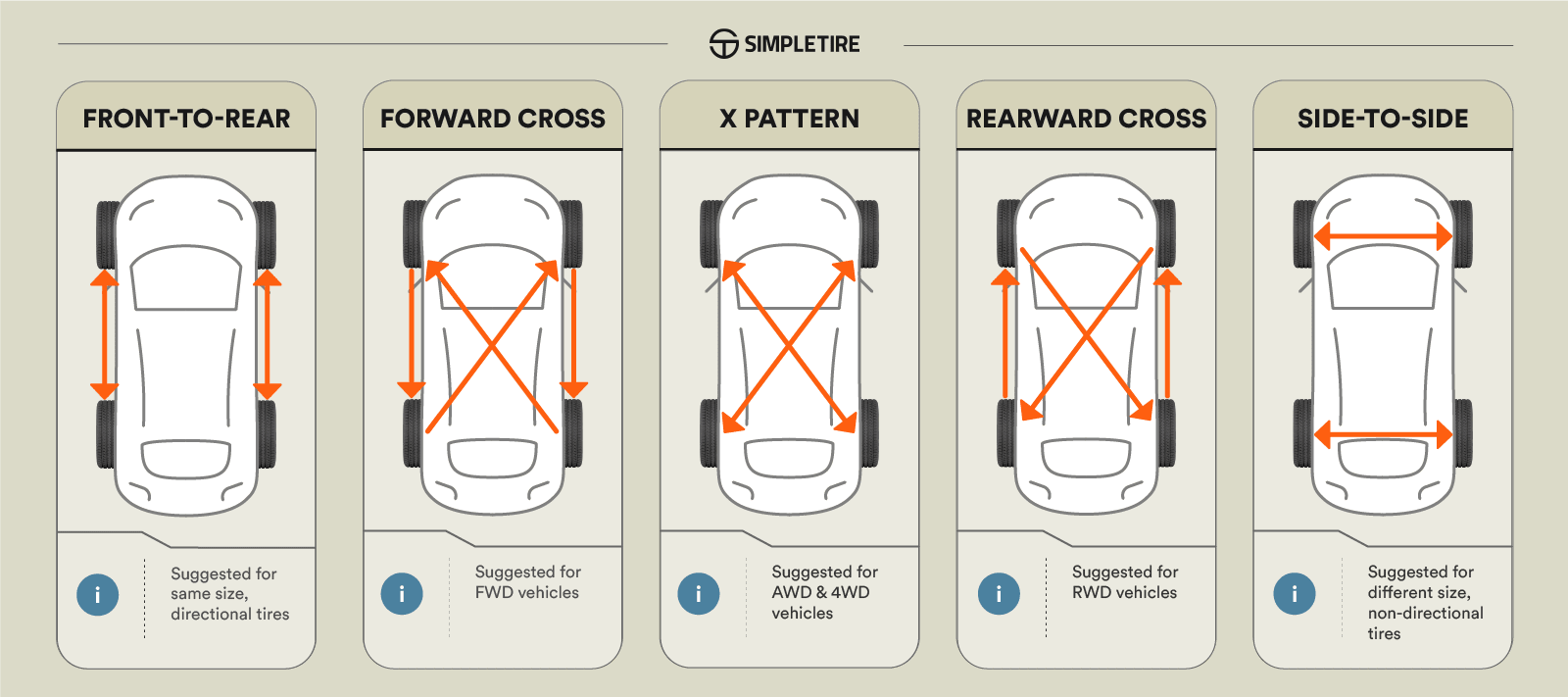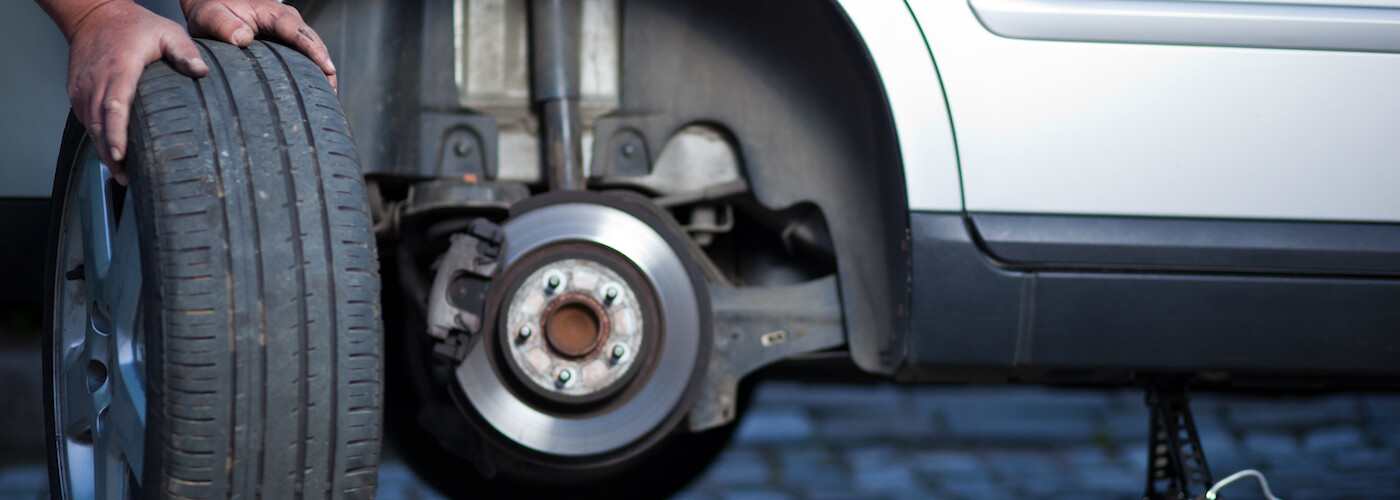Tire Maintenance & Safety
Free shipping
Best price guarantee
Special pricing
Financing with Resolve
Easy returns

Tire rotation is a crucial aspect of vehicle maintenance that often goes overlooked. Many drivers are unaware of the benefits regular tire rotation provides, such as extending tire life and ensuring optimal vehicle performance.
Rotating your tires at the recommended intervals helps distribute wear evenly across all four tires. This practice not only maximizes the lifespan of your tires but also maintains proper traction, handling, and overall safety.
In this comprehensive guide, we'll delve into the importance of tire rotation and provide step-by-step instructions on how to rotate your tires at home. By the end of this article, you'll have the knowledge and confidence to tackle this essential maintenance task yourself.
Why rotate your tires?
Tire rotation is the process of moving tires from one position on a vehicle to another to ensure even tire wear. This simple yet effective maintenance practice helps extend the life of your tires by distributing wear patterns evenly across all four tires.
When tires remain in the same position for an extended period, they develop unique wear patterns based on factors such as the vehicle's weight distribution, driving habits, and road conditions. For example, front tires on a front-wheel drive vehicle tend to wear faster due to the added stress of steering and acceleration. By rotating the tires regularly, you can minimize uneven wear and maintain optimal tire performance.
Regular tire rotation also plays an important role in maintaining your vehicle's safety and handling. Evenly worn tires provide better traction, braking performance, and overall stability, especially in challenging weather conditions. Neglecting to rotate your tires can lead to premature wear, reduced tread life, and potentially dangerous handling issues.
Additionally, many tire manufacturers require regular rotations to maintain the validity of their tread wear warranty. By following the recommended rotation schedule, you not only extend the life of your tires but also ensure that you're eligible for warranty coverage if any issues arise.
How to Rotate Tires

First, position your vehicle on a level surface and set the parking brake. This precaution ensures stability and prevents any movement during the process. Before raising the vehicle, slightly loosen the lug nuts on each wheel to make them easier to remove once the vehicle is lifted.
Then, gather the necessary tools: a sturdy jack, a lug wrench, and jack stands. These are essential for lifting and securing the vehicle safely while you perform the tire rotation. Use the jack to elevate one corner of the vehicle and place a jack stand underneath to hold it securely. Repeat this step for each corner to ensure the vehicle is stable.
With the vehicle lifted, select the correct rotation pattern based on your vehicle's drivetrain. For front-wheel drive vehicles, apply the forward-cross pattern: shift the front tires to the rear on the same side and cross the rear tires to the front. For rear-wheel drive or four-wheel drive vehicles, use the rearward-cross pattern: move rear tires to the front on the same side, and cross the front tires to the rear. The X-pattern is suitable for all-wheel drive vehicles, where each tire moves diagonally. This helps in achieving even wear and balanced handling.
As you rotate the tires according to the chosen pattern, remove each tire carefully, reposition it, and hand-tighten the lug nuts. After all tires are in their new positions, lower the vehicle and tighten the lug nuts in a crisscross pattern to ensure even distribution of pressure. This final step is vital to prevent any imbalance while driving. Perform a last check to confirm all lug nuts are secured properly.
Step 1: Prepare your vehicle
Begin by selecting a level and firm surface for your vehicle to rest on. Ensure the vehicle is securely parked with the parking brake engaged to maintain stability throughout the process. Before lifting, use a lug wrench to slightly loosen the lug nuts on each wheel; this will simplify the removal process once the vehicle is off the ground.
Proceed with using a dependable jack to elevate the vehicle. Identify the appropriate lifting points as specified in the vehicle's manual to prevent damage. Once the vehicle is lifted to the necessary height, slide jack stands into place to provide robust support. This crucial step ensures the vehicle remains stable, allowing you to work safely and efficiently.
Verify that each jack stand is positioned correctly and securely. This confirmation step is vital for your safety as you move forward with the tire rotation. Proper preparation is key to a smooth and effective tire rotation process, ensuring each step can be executed safely and without unnecessary complications.
Step 2: Choose the Right Rotation Pattern
Deciding on the correct rotation pattern is crucial for ensuring even tire wear and optimal performance. For front-wheel drive (FWD) vehicles, the forward-cross method works best. This pattern involves taking the front tires and moving them directly to the back, while the rear tires are brought forward but swapped to the opposite sides. This addresses the heavy wear on front tires due to steering and power output.
For rear-wheel drive (RWD) and four-wheel drive (4x4) vehicles, opt for the rearward-cross approach. In this arrangement, the rear tires transition to the front positions on the same side, while the front tires are moved to the back and crossed over. This method helps balance the wear and tear, considering rear tires handle the driving force.
All-wheel drive (AWD) vehicles benefit from the X-pattern, which is well-suited for distributing wear evenly across all tires. Each tire moves diagonally to the opposite position, catering to the need for uniform tire conditions due to the AWD system's balanced power distribution. Implementing the appropriate rotation pattern is essential for maintaining your vehicle’s stability and performance on various roads.
Step 3: Rotate the Tires
With the vehicle securely supported by jack stands, you can now commence the tire rotation process. Begin by fully removing the previously loosened lug nuts and carefully set aside each tire. This part of the process demands precision—document the original position of each tire to ensure accurate placement in their new locations.
Once a tire is removed, carry it to its designated position according to your chosen rotation strategy. Align the tire with the wheel hub and initially tighten the lug nuts with your fingers to prevent damage to the threads. This careful alignment is crucial for maintaining wheel balance and avoiding vibrations while driving. Ensure the tire is seated evenly against the hub, which is vital for uniform wear and optimal performance.
After repositioning all tires, proceed to tighten the lug nuts using a torque wrench to the values specified in your vehicle's manual. This guarantees each tire is secure and prevents uneven pressure that could lead to handling issues. Confirm that all lug nuts are tightened correctly, ensuring the vehicle's stability and safety throughout your travels.
Step 4: Secure the Tires
Securing the tires is an essential step in the rotation process, crucial for maintaining vehicle safety and performance. Begin by fastening the lug nuts in a diagonal sequence. This approach balances the wheel's attachment to the hub, ensuring it sits flush and secure. Start with one lug nut, then proceed to the one directly across from it, continuing this alternating pattern. This strategy prevents potential misalignment and ensures a secure fit.
After snugging the lug nuts by hand, switch to a torque wrench to apply the precise amount of force recommended in your vehicle's manual. This instrument provides the necessary accuracy to avoid issues associated with excessively tight or loose nuts, which can lead to wheel damage or detachment. Set the wrench to the specified torque value and methodically secure each lug nut, confirming uniformity across all wheels.
Once all lug nuts are correctly fastened, carefully lower the vehicle onto the ground. Remove the jack stands and let the vehicle rest firmly on its tires. Conduct a thorough inspection to ensure every lug nut is securely tightened. This comprehensive check guarantees that your tires are ready for safe driving, giving you confidence in your vehicle's reliability.
Tips on Tire Rotation

Keeping your tires in top condition requires regular attention — tire rotation plays a vital role in this. By focusing on this practice, you enhance your vehicle's reliability and driving experience. Here are some essential tips to maximize the benefits of tire rotations.
1. Rotate your tires every 5,000 to 7,000 miles for best results.
Following a routine tire rotation schedule is essential. Aim to rotate your tires every 5,000 to 7,000 miles, which often aligns with regular maintenance checks like oil changes. This interval helps distribute wear evenly across the tires, which is crucial for maintaining balanced performance and prolonging the life of your tires.
2. Check tire pressure and tread depth during each rotation.
Incorporate a thorough tire inspection into your rotation routine. Proper tire inflation supports better handling and efficiency; use a tire gauge to verify and adjust the pressure according to the manufacturer's specifications. Also, monitor tread depth to ensure it meets safety standards. A quick check with a penny can help you determine if your tread is adequate — if the top of Lincoln's head is visible, it’s time to consider new tires. These checks ensure your vehicle remains safe and efficient on the road.
3. Consider professional services if unsure.
Performing tire rotation can be straightforward, but professional assistance is always available. If you're not equipped with the right tools or the confidence to rotate tires yourself, consulting a professional is a wise decision. Experts can efficiently handle the rotation process and identify any potential issues, ensuring your tires are optimally placed and your vehicle remains in top condition. Whether you opt for DIY or professional help, regular tire rotation is key to maintaining your vehicle’s overall performance and safety.
By following this step-by-step guide, you can confidently rotate your tires at home and keep your vehicle running smoothly. Remember, regular tire rotation is a simple yet effective way to maximize tire life and maintain optimal performance. If you need assistance or want to explore a wide selection of high-quality tires, visit SimpleTire.com — we're here to help you find the perfect tires for your vehicle at the best prices.
Ready to find the perfect tires?
Search By